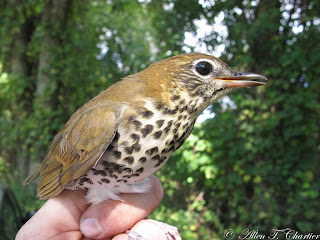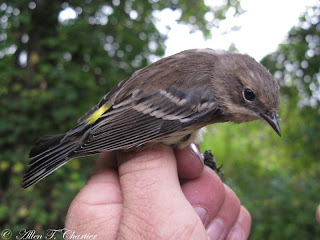Banding highlights from Friday, September 25 included a Ruby-throated Hummingbird, possibly the last one of the season. The almost complete lack of Jewelweed (Impatiens capensis) flowers in the banding area has clearly had an impact. Normally there would be hundreds of plants with dozens of flowers on each plant. But this year the deer have so completely devastated the Jewelweed that perhaps at most one plant in five has a single flower on it. The first Blue-headed Vireos (3) of the fall season were captured today.
Hatch-year Blue-headed Vireo
Winter Wrens were first detected last week, but the first ones were banded today.
Hatch-year Winter Wren
Hatch-year Hermit Thrush
Somewhat surprising was the capture of a Wood Thrush. They've been caught later here, but any time after September 20 is unexpected.
Hatch-year Wood Thrush
The first Orange-crowned Warbler was captured today, just about on time for the species. Often there are reports of this species in early September and even late August. No less an authority than Jon Dunn has suggested that any claim of Orange-crowned Warbler in the Great Lakes earlier than about September 20 should be carefully scrutinized. Many observers may not realize how green juvenile Tennessee Warblers can be in the fall, and neglect to check the single best field mark, the color of the undertail coverts. While they can be pale yellowish (but most often bright white) in Tennessee Warbler, they are bright lemon yellow in Orange-crowned Warbler. Both species were captured today, and photos below may help resolve some of this confusion. Also, compare the photo of the hatch-year Tennessee Warbler with those of the second-year females posted earlier this month.
Hatch-year Tennessee Warbler
Hatch-year male Orange-crowned Warbler
As noted, White-throated Sparrows arrived in force, with the handsome individual in the photo below only one of 32 banded today.
Hatch-year White-throated Sparrow
A species we don't catch very often, as they tend to feed in areas with more open spaces, is White-crowned Sparrow, so this individual was a little unusual.
Hatch-year White-crowned Sparrow
Hatch-year female Dark-eyed Junco
Interesting birds observed today but not banded included 2 Cooper's Hawks, 2 Red-tailed Hawks, and a Veery calling before dawn. A couple small groups of Golden-crowned Kinglets signalled their first arrival for the fall.
Banding highlights from Saturday, September 26 included species that aren't banded here very often. A Yellow-bellied Sapsucker was only the second one banded here since 2004, and only the 8th one since 1989.
Hatch-year female Yellow-bellied Sapsucker
Eastern Phoebes aren't banded as often in the fall as they are in spring, and the one captured today was a little early for the first of season.
After hatch-year Eastern Phoebe
Other flycatchers captured today, both a little later than normal, were single Yellow-bellied and Least Flycatchers. Additional Winter Wrens, Hermit Thrushes, and Orange-crowned Warblers added to yesterday's totals. A flock of American Robins in the Upland Nets was unusual for so late in September in the banding area; usually they abandon the area by the end of August. A single Yellow-rumped Warbler was the first of the season, hopefully the first of many more to come.
Hatch-year female Yellow-rumped Warbler
A single Wilson's Warbler was a little bit late, and Lincoln's Sparrows were clearly peaking with 4 banded today. Another Dark-eyed Junco was as unexpected today as were the 3 banded yesterday. After just having discussed the diminishing possibility of catching a Rose-breasted Grosbeak with one of the volunteers, there was one out in the Field Nets not more than an hour later!
Hatch-year female Rose-breasted Grosbeak
With a powerful bill like that, there's NO WAY I'm going to hold it in the "photographer's grip" just for a decent photo on the blog. I don't need bloody fingers from that bite! Here I'm holding it in the "banders grip" which is safe and gentle for both the bird and the bander.
Interesting birds observed today but not banded included calling Great Horned Owls before dawn, a Cooper's Hawk, at least one other Yellow-bellied Sapsucker that was heard while banding another, and a briefly singing Marsh Wren in the dying Phragmites stand near the Field Nets. Golden-crowned Kinglets were in the banding area again today, but not captured. Soon we'll have many!
Many thanks to the volunteers who made banding possible on these two days: John Bieganowski, Andrea Charlebois, Chris Charlebois, Jacob Charlebois, Amanda Grimm, Dave Lancaster, Jennifer Philpot-Munson, and Tom Schlack.
====================
Banding Data-------------------------------------
FRIDAY, September 25, 2009
Sunrise (E.S.T.): 6:22
Time Open (E.S.T.): 5:45
Time Closed (E.S.T.): 13:00
Hours Open: 7.25
No. of Nets: 5.00-13.25
Net Hours: 88.563
Temperature (F): 57-72
Cloud Cover: 80-50%
Wind: NE-E @ 3-5-15 mph
Barometer: 30.29-30.33
Precipitation: None
No. Banded: 128 (plus 6 recaptured and 1 released unbanded)
No. of Species: 32
Capture Rate: 152.4 birds per 100 net hours
Volunteers: John Bieganowski, Amanda Grimm, Dave Lancaster, Tom Schlack
Ruby-throated Hummingbird - 1
Least Flycatcher - 1
Blue-headed Vireo - 3
Red-eyed Vireo - 2
[Black-capped Chickadee - 1 recaptured]
Brown Creeper - 2
House Wren - 4 (plus 1 recaptured)
Winter Wren - 2
Ruby-crowned Kinglet - 3
Gray-cheeked Thrush - 3
Swainson's Thrush - 7
Hermit Thrush - 9 (plus 1 released unbanded)
Wood Thrush - 1
American Robin - 1
Gray Catbird - 6 (plus 1 recaptured)
Tennessee Warbler - 3
Orange-crowned Warbler - 1
Nashville Warbler - 7
Magnolia Warbler - 5
Black-throated Blue Warbler - 6
Black-and-white Warbler - 1
American Redstart - 3
Ovenbird - 1
Common Yellowthroat - 1 (plus 1 recaptured)
Song Sparrow - 4 (plus 2 recaptured)
Lincoln's Sparrow - 3
Swamp Sparrow - 10
White-throated Sparrow - 32
White-crowned Sparrow - 1
Dark-eyed Junco - 1
Northern Cardinal - 1
American Goldfinch - 1
-------------------------------------
SATURDAY, September 26, 2009
Sunrise (E.S.T.): 6:23
Time Open (E.S.T.): 5:45
Time Closed (E.S.T.): 12:15
Hours Open: 6.50
No. of Nets: 5.00-13.25
Net Hours: 79.750
Temperature (F): 58-64
Cloud Cover: 100%
Wind: NE-SE @ 3-5-7 mph
Barometer: 30.10-29.97
Precipitation: Trace just before early closure
No. Banded: 120 (plus 10 recaptured and 1 released unbanded)
No. of Species: 29
Capture Rate: 164.3 birds per 100 net hours
Volunteers: Andrea Charlebois, Chris Charlebois, Jacob Charlebois, Jennifer Philpot-Munson
YELLOW-BELLIED SAPSUCKER - 1
Yellow-bellied Flycatcher - 1
Least Flycatcher - 1
Eastern Phoebe - 1
Red-eyed Vireo - 1
Black-capped Chickadee - 1 (plus 2 recaptured)
House Wren - 3 (plus 1 recaptured)
Winter Wren - 5
Ruby-crowned Kinglet - 3
Gray-cheeked Thrush - 4
Swainson's Thrush - 6
Hermit Thrush - 4 (plus 1 recaptured)
American Robin - 10 (plus 1 recaptured)
Gray Catbird - 6 (plus 2 recaptured)
Orange-crowned Warbler - 3
Nashville Warbler - 3 (plus 1 released unbanded)
Magnolia Warbler - 1
Black-throated Blue Warbler - 4
Yellow-rumped Warbler - 1
Common Yellowthroat - 2
Wilson's Warbler - 1
Song Sparrow - 5 (plus 1 recaptured)
Lincoln's Sparrow - 4
Swamp Sparrow - 13 (plus 2 recaptured)
White-throated Sparrow - 31
Dark-eyed Junco - 1
Northern Cardinal - 1
Rose-breasted Grosbeak - 1
American Goldfinch - 1








































